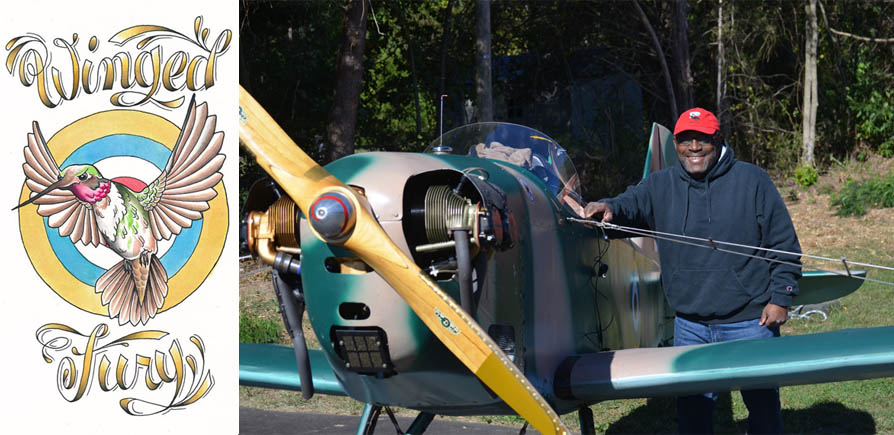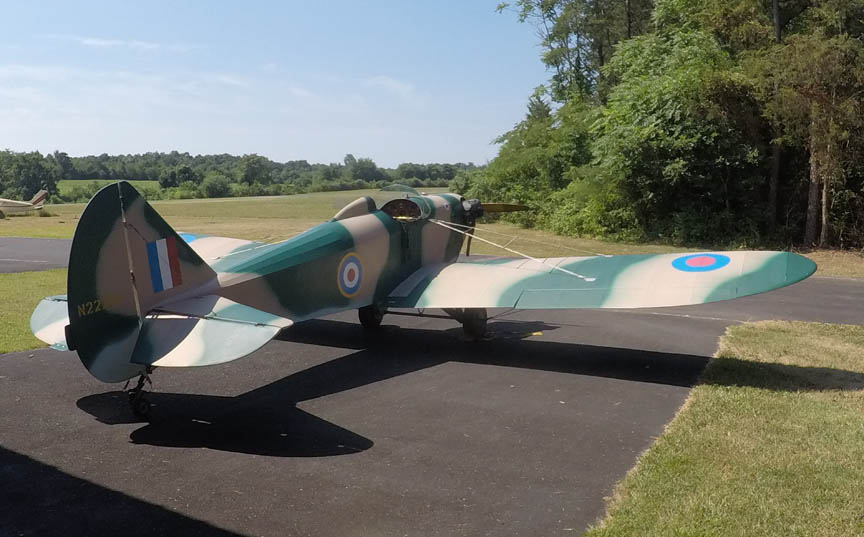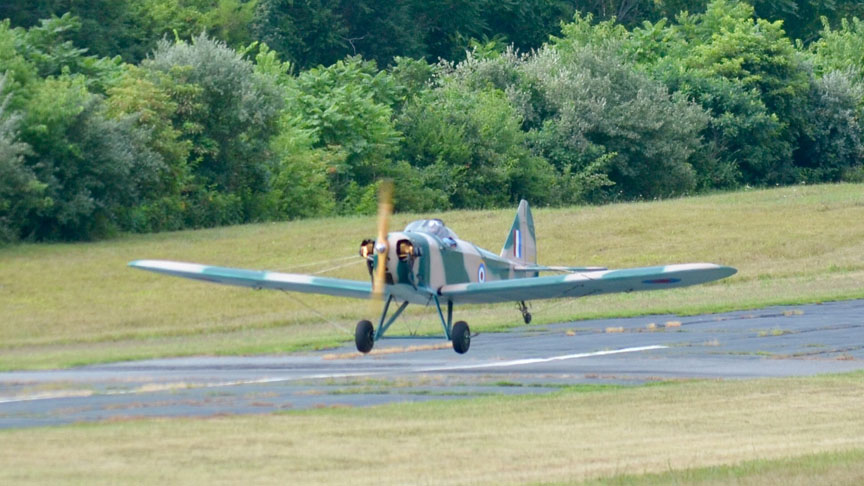
[RJW Note: Bill Hills bought his Fly
Baby in 2017. He posted this tale to the Fly Baby
mailing list the following February]
The temperature hit 55-60 last weekend, enabling me to shed almost all of the cold weather gear I’ve put together to fly Winged Fury all winter. So I went to Gordonsville Municipal Airport (GVE), where I currently base my FB, on Saturday to attend a FAAST lecture on maintenance related accident prevention hosted by EAA Chapter 1563 and, of course, to fly in the afternoon.
Gordonsville Airport is a great little municipal airport located right at the foothills of the Blue Ridge/Shenandoah Mountains in Virginia a few miles north of Charlottesville. It’s east-west 2300 by 40-foot runways, 05 and 23, show much wear, but are more than adequate for the most general aviation aircraft. Like all too many small airports, it is struggling to carry on its proud 80+ years of supporting general aviation and the joy of flying. It is anchored by a small and wonderful group of fliers and non-flyers along with the occasional onlooker. Hamburgers and hotdogs, along with other pot-luck dishes, are served nearly every weekend by the unofficial airport manager who lives with his wife and dog in a lovely apartment they built on top of one of the hangers. With no fuel on the field and relatively short runways, 23 has a 440 foot displaced threshold, there is generally little activity.
Sitting in the FAAST lecture, little did I know how prophetic the topic would be. The lecture was very good, albeit, somewhat depressing and definitely thought-provoking. It highlighted numerous aviation accidents attributable to small sequences of maintenance events that ultimately resulted in an accident, some fatal and some not. As you might expect, many examples fell into the category of “shoulda, woulda, coulda.” While I didn’t have a major issue, my incident later that afternoon clearly fell into that category.
After the lecture and a hearty meal and some light ‘hangar flying’, I went about getting ready to fly. I launched after a detailed preflight, including a check of the integrity of the pitot and static tubes protruding from the left wing (hint, hint). I had plans for a leisurely flight to the east around Lake Anna, a large recreational reservoir 10 miles to the east, followed by some meandering to the west in the Shenandoah Mountains of Virginia.

In route to Lake Anna from GVE, I did a couple of circuits around Lake Louisa (about 5 miles to the east) where one of my co-workers has a lake house and loves to guess if he’s seen me in the air or not. This time he did. I went on to fly the length of Anna enjoying the 50 degrees + day when I noticed that the pitot/static tube array protruding from my left wing appeared to be sagging slightly. My first thought literally was ‘well, that doesn’t look right!’ So I immediately decided to go to Lake Anna Airport to land and confirm that I wasn’t just seeing things. Direct to Lake Anna required a 90-degree turn to the left and it was easily visible from my position over the lake, approximately 6 miles away. By the time I finished the turn and dialed in Lake Anna AWOS, the tube assembly was gone and my flight instruments were completely erratic. The airspeed indicator was reading a solid zero, except at high angles of attack. The altimeter was bouncing around, but generally reading 2400 MSL and the vertical speed indicator was oscillating all over the place.
At this point, right or wrong, I made the decision to return to GVE. The logic was that I was only going to make one landing, so I should do it at the airport I was most familiar with and, candidly, the one that was most convenient. I returned using the instrumentation provided in ForeFlight, estimating airspeed using the winds reported by the GVE’s AWOS and ForeFlight’s reported ground speed.
Upon arrival at GVE, the winds were reported at 12 knots gusting to 14 right down the runway so I proceeded to the left-hand pattern for runway 23. My plan was to fly the approach, estimating and calculating airspeed to be on the fast side. If it felt too fast for GVE’s relatively short runway, I’d abort the landing and head to Orange County Airport with its much, much longer and wider runways.

As it turns out everything felt, looked and sounded (the wires were singing) routine. I got down to flare at the displaced threshold and everything still felt normal so I let it settle into a nice, greaser of a wheel landing. In fact, it was the best one I’ve made thus far! Roll out was normal, suggesting that I was pretty much on speed and proceeded to my hanger.
So why did this happen? The pitot and static tubes on my FB are (I mean were) only forced squeezed into openings for them in the wing. They get bumped often while moving around the plane. When I purchased the plane both the A&P (who did the pre-purchase and subsequent condition inspection) and I made the observation that we should come up with a more secure arrangement, but in the spirit of deferred maintenance (aka anxious to fly) and the fact that they’d been there for years, I did nothing, a key element of risk highlighted in the morning lecture! While I check them in every preflight, this time I bumped into them while removing the chocks during a solo start, one of the few times I’ve removed them from the front vs crawling under the wing from the back. Although I checked them again, I was probably more concerned with getting in the plane while the engine was running and it was only secured by the tail tie-down. The check was clearly inadequate, they vibrated loose and departed the aircraft in flight. It was the string of little things the lecturer described on the way to an accident/incident. Lesson learned!
I’m now in the process of replacing it with something more secure and feeling grateful that I got comfortable enough with Winged Fury that the landing was familiar and uneventful.
Bill Hills
The temperature hit 55-60 last weekend, enabling me to shed almost all of the cold weather gear I’ve put together to fly Winged Fury all winter. So I went to Gordonsville Municipal Airport (GVE), where I currently base my FB, on Saturday to attend a FAAST lecture on maintenance related accident prevention hosted by EAA Chapter 1563 and, of course, to fly in the afternoon.
Gordonsville Airport is a great little municipal airport located right at the foothills of the Blue Ridge/Shenandoah Mountains in Virginia a few miles north of Charlottesville. It’s east-west 2300 by 40-foot runways, 05 and 23, show much wear, but are more than adequate for the most general aviation aircraft. Like all too many small airports, it is struggling to carry on its proud 80+ years of supporting general aviation and the joy of flying. It is anchored by a small and wonderful group of fliers and non-flyers along with the occasional onlooker. Hamburgers and hotdogs, along with other pot-luck dishes, are served nearly every weekend by the unofficial airport manager who lives with his wife and dog in a lovely apartment they built on top of one of the hangers. With no fuel on the field and relatively short runways, 23 has a 440 foot displaced threshold, there is generally little activity.
Sitting in the FAAST lecture, little did I know how prophetic the topic would be. The lecture was very good, albeit, somewhat depressing and definitely thought-provoking. It highlighted numerous aviation accidents attributable to small sequences of maintenance events that ultimately resulted in an accident, some fatal and some not. As you might expect, many examples fell into the category of “shoulda, woulda, coulda.” While I didn’t have a major issue, my incident later that afternoon clearly fell into that category.
After the lecture and a hearty meal and some light ‘hangar flying’, I went about getting ready to fly. I launched after a detailed preflight, including a check of the integrity of the pitot and static tubes protruding from the left wing (hint, hint). I had plans for a leisurely flight to the east around Lake Anna, a large recreational reservoir 10 miles to the east, followed by some meandering to the west in the Shenandoah Mountains of Virginia.

In route to Lake Anna from GVE, I did a couple of circuits around Lake Louisa (about 5 miles to the east) where one of my co-workers has a lake house and loves to guess if he’s seen me in the air or not. This time he did. I went on to fly the length of Anna enjoying the 50 degrees + day when I noticed that the pitot/static tube array protruding from my left wing appeared to be sagging slightly. My first thought literally was ‘well, that doesn’t look right!’ So I immediately decided to go to Lake Anna Airport to land and confirm that I wasn’t just seeing things. Direct to Lake Anna required a 90-degree turn to the left and it was easily visible from my position over the lake, approximately 6 miles away. By the time I finished the turn and dialed in Lake Anna AWOS, the tube assembly was gone and my flight instruments were completely erratic. The airspeed indicator was reading a solid zero, except at high angles of attack. The altimeter was bouncing around, but generally reading 2400 MSL and the vertical speed indicator was oscillating all over the place.
At this point, right or wrong, I made the decision to return to GVE. The logic was that I was only going to make one landing, so I should do it at the airport I was most familiar with and, candidly, the one that was most convenient. I returned using the instrumentation provided in ForeFlight, estimating airspeed using the winds reported by the GVE’s AWOS and ForeFlight’s reported ground speed.
Upon arrival at GVE, the winds were reported at 12 knots gusting to 14 right down the runway so I proceeded to the left-hand pattern for runway 23. My plan was to fly the approach, estimating and calculating airspeed to be on the fast side. If it felt too fast for GVE’s relatively short runway, I’d abort the landing and head to Orange County Airport with its much, much longer and wider runways.

As it turns out everything felt, looked and sounded (the wires were singing) routine. I got down to flare at the displaced threshold and everything still felt normal so I let it settle into a nice, greaser of a wheel landing. In fact, it was the best one I’ve made thus far! Roll out was normal, suggesting that I was pretty much on speed and proceeded to my hanger.
So why did this happen? The pitot and static tubes on my FB are (I mean were) only forced squeezed into openings for them in the wing. They get bumped often while moving around the plane. When I purchased the plane both the A&P (who did the pre-purchase and subsequent condition inspection) and I made the observation that we should come up with a more secure arrangement, but in the spirit of deferred maintenance (aka anxious to fly) and the fact that they’d been there for years, I did nothing, a key element of risk highlighted in the morning lecture! While I check them in every preflight, this time I bumped into them while removing the chocks during a solo start, one of the few times I’ve removed them from the front vs crawling under the wing from the back. Although I checked them again, I was probably more concerned with getting in the plane while the engine was running and it was only secured by the tail tie-down. The check was clearly inadequate, they vibrated loose and departed the aircraft in flight. It was the string of little things the lecturer described on the way to an accident/incident. Lesson learned!
I’m now in the process of replacing it with something more secure and feeling grateful that I got comfortable enough with Winged Fury that the landing was familiar and uneventful.
Bill Hills
 Return to the Stories Page
Return to the Stories Page